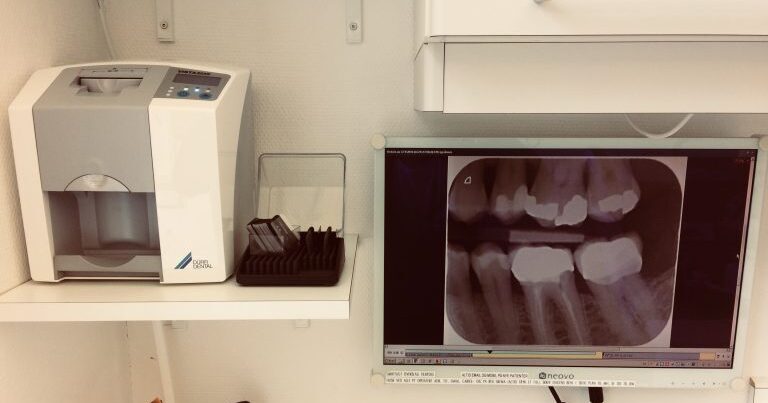A standard examination at the dentist consists of an examination and cleansing followed with X-rays. The frequency of visits depends on how your condition is.
Examination
The first thing that is done when you sit in the dental chair is an examination. Marianne examines your teeth and gums etc. to make sure everything is as it should be, or to check out already known issues. Often, it happens that she discovers something you do not have discovered yourself. It can be some irritated gums, a small tab you have broken off a tooth, and maybe a cavity that can be very difficult to spot. The examination also works preventively on anything other than cavities, as several diseases appear in the oral cavity. Your dentist may therefore be the first to spot these, where time can play a crucial role.
X-Ray

Digital X-ray is the most recent way to record and evaluate x-rays. It gives less radiation (90% less), is induced in about 1 minute and the images are in a very high quality. These images are viewed on a computer screen, which makes it easier to see, identify and understand any problems. In addition, this new technology is environmentally friendly, as no chemicals are used to propagate the image.
An x-ray gives your dentist a deeper insight into your health as it shows everything you can’t see on the surface. X-ray can reveal ‘hidden’ cavities between teeth or on teeth that have been artificially attached, eg a crown. The pictures also tell about the condition of the bone itself, as well as about the root tips of the teeth, where there can often be problems.
Taking an X-ray only takes a short moment, and is basically painless and for the most people not unpleasant. It may feel a little uncomfortable if there are taken photos of your wisdom teeth or if you have a very small mouth. We do everything we can to make the process run as quickly as possible so that you experience the least possible discomfort.
In special cases, we refer you externally to have a CBCT scan of your jaw. This is done if a complicated treatment is to be performed where we either need to be sure where the nerve in your jaw is located or to get an accurate picture of how much bone you have left, typically in connection with implant treatment.
Camera
Sometimes we use a small camera that fits in the mouth to show details of the tooth. The picture is shown on the computer screen so it is also visible for you. Sometimes we use a regular camera, to show you our findings. These pictures will not be stored on the camera but will be deleted.
Cleaning
As a starting point, a tooth cleaning is performed when you visit us, and is usually done after the examination and possibly X-rays.
Easy/light tooth cleaning
If your teeth and gums are fine, you get a light tooth cleaning. This involves removal of tartar and polishing. At the clinic we have ultrasound available, which is used to remove tartar. You will not experience the ‘scarce’ normal hand instruments that many find uncomfortable. When your teeth are drenched, some kind of coarse toothpaste is used, which also slightly grinds your teeth. In this way, superficial discolorations are removed and your teeth become beautiful and smooth.
Extended tooth cleaning
As Marianne is a periodontal specialist, it is often an extended tooth cleaning that is given. As with the light tooth cleaning, it is finished with a trimming, but the removal of tartar is more thorough and she takes care of getting into the gum pockets around the exposed teeth. A thorough tooth cleansing is the first step in the fight against parental dysfunction.
